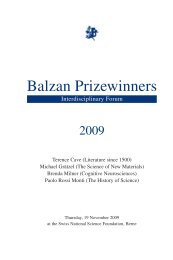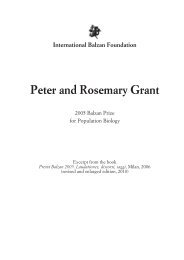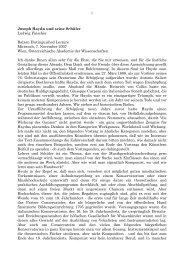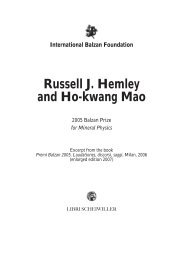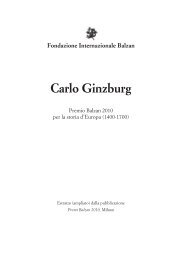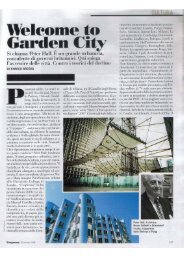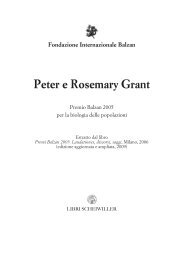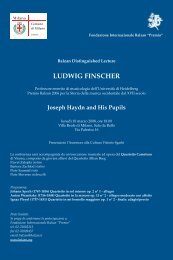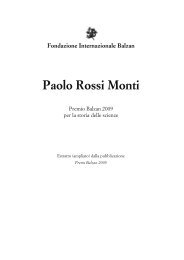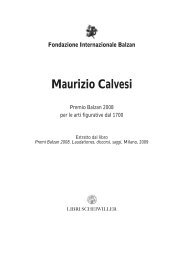International Balzan Foundation Luigi Luca Cavalli
International Balzan Foundation Luigi Luca Cavalli
International Balzan Foundation Luigi Luca Cavalli
You also want an ePaper? Increase the reach of your titles
YUMPU automatically turns print PDFs into web optimized ePapers that Google loves.
<strong>Luigi</strong> <strong>Luca</strong> <strong>Cavalli</strong>-Sforza<br />
The study of evolution received a solid framework with the introduction of a<br />
mathematical theory which was developed between 1918 and 1950 by three<br />
great scientists, Sir Ronald A. Fisher, J. B. S. Haldane and Sewall Wright. From<br />
1948 to 1950 I had the good fortune to work with Sir Ronald Fisher in Cambridge<br />
and derived great benefit from the relationship. Soon after this, I found<br />
myself asking the question as to whether it would be possible to reconstruct the<br />
evolutionary history of man by analysing the genetic differences between humans<br />
living today. At that time there were not yet sufficient genetic population<br />
data. Knowledge was limited to the frequency distributions of certain blood<br />
groups, including the so-called ABO system used for blood transfusions, and<br />
the famous rhesus system, as well as a few others. So until enough additional scientific<br />
knowledge could be collected to form a critical mass, the time could be<br />
devoted to studying the theory of evolution. At that time, there were two fundamentally<br />
different views as to the significance of the two major evolutionary<br />
factors: natural selection, on the one hand, and on the other, the effects of<br />
chance due to the limited size of populations. This inevitably leads to fluctuations<br />
in the statistical frequency of occurrence of genetic characteristics, and<br />
their effects would accumulate over generations.<br />
There was absolutely no doubt that natural selection played a central role. The<br />
influence of chance had already been especially investigated by one of the fathers<br />
of the mathematical theory of evolution, Sewall Wright, but there were still<br />
no usable empirical data. In passing, I am pleased to be able to remind you that<br />
Sewall Wright was awarded the <strong>Balzan</strong> Prize in 1984, having outlived the other<br />
two great scientists by a good many years. The other geneticist who has so far<br />
had the honour of receiving this prize was John Maynard Smith, who was one of<br />
the most brilliant students of J. B. S. Haldane. So we have the interesting coincidence<br />
that of the three geneticists who have been awarded the <strong>Balzan</strong> Prize<br />
until now, Sewall Wright was the last of the three great names who was still alive,<br />
and the other two were students of Haldane and Fisher.<br />
I set out to solve the problem of how to measure the effects of chance on genetic<br />
variation by studying a population group in the neighbourhood of the University<br />
of Parma where I was teaching in the nineteen-fifties. The idea was that<br />
it should be easy to predict the effects of chance on the genetic differences between<br />
the various villages, by using demographic data reconstructed on the basis<br />
of church records of births, marriages and deaths going back to the year<br />
7



